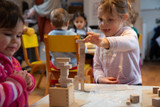The Woman Who Transformed How Schools Teach Geography
During Zonia Baber’s time, in the 1900s, geography was viewed more as a means of colonisation than about understanding different cultures. Baber’s work revolved around transforming this mindset so geography education could become meaningful and worthwhile for students to understand the different cultures.
Here’s how geography education has changed:
- By the 18th to the 19th century
Around this time, geography was a feminised branch of science as it appealed to the American values of nationalism, utility, and self-improvement. Cultural beliefs relegated women to the roles of stay-at-home mothers and teachers, which put them in a unique position to impart values on the next generation. Zonia Baber on a geology class field trip (circa 1895)
Zonia Baber on a geology class field trip (circa 1895)
- By the late 19th century
The field of geography was being used to develop a culture of national pride, as well as imperialist agendas of European countries. - Late 19th century and early 20th century
During Baber’s time, geographers developed a different mindset. They now believed that the environment influenced culture and national accomplishments, and that Western culture was the highest standard of cultural achievement. This line of thought justified the move by white Westerners to occupy lands considered ‘less civilised’ -- also referred to as a Eurocentric worldview.
Baber Challenges the Eurocentric Worldview
Baber spent most of her childhood in Paris, Illinois. She then attended a teacher’s college where she studied to become a geography teacher. She continued with her studies in geography and geology at the University of Chicago.
In 1895, Baber developed progressive beliefs about geography education. She formalised her activist approach to geography and progressive teaching methods, which essentially set her apart from contemporary geographers at the time.
Her teaching methods were holistic. She proposed that the branches of knowledge were interdependent, not disparate as other geographers believed. She also argued that the proper understanding of geographic facts required knowledge of history, science, and mathematics, as well as expression in reading, modelling, writing, and drawing. Moreover, she proposed that:
- Children should get out of classrooms. Although textbooks are useful, geography students need to see and experience things beyond their own immediate environment
- Fieldwork was the ideal measure of progress for teaching geography. These could be achieved through field trips or lab work, or both.
- Field trips are essential: This was especially beneficial for students in underfunded school districts because trips provided real-world insight on course work.
- Lab work or hands-on personal experiences. This was necessary to help students relate to the subject matter on a more personal level.
- Map making. The objective is to help students understand that the symbols used on maps correspond to reality -- physical landscape and real places.
Baber managed to change how schools teach geography, by encouraging students to share knowledge and perspectives as opposed to dividing them based on cultural differences.
Thinkamajigs is a supplier of innovative educational toys, games, and teaching materials. To see how we can help you and your little thinker, shop our online store or contact us.
LATEST BLOG POSTS
How To Set Up A Montessori Environment At Home
Creating a Montessori-inspired environment at home provides the opportunity to support your child's...
Montessori & Technology: do they play well together?
Dr. Maria Montessori’s method of teaching children emphasizes the use of concrete materials and hand...
Froebel Gifts: An Introduction
You may have heard of Fröebel Gifts (we carry the full selection here), but you may also wonder what...
Safe Toys for Toddlers: What Parents Should Know
As a parent, you want to be sure that any toys your toddler plays with are safe and age-appropriate....
Infant & Toddler Toy Guide - Part 2
THINKAMAJIGS’ GUIDE TO CHOOSING EDUCATIONAL TOYS FROM BIRTH TO AGE 3PART 2: AGE-RELATED DEVELOPMENTA...
Infant & Toddler Toy Guide - Part 1
THINKAMAJIGS’ GUIDE TO CHOOSING EDUCATIONAL TOYS FROM BIRTH TO AGE 3PART 1: SKILLS DEVELOPMENT“What...







